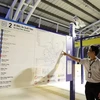The Cultural Heritage Department under the Ministry of Culture, Sports and Tourism will invest 3 billion VND (144,000 USD) next year to combat termites that have been damaging historic houses in Hoi An ancient town in central Quang Nam province for a long time.
This decision was made after initial investments in termite and insect eradication had shown positive results in recent years, said Nguyen Duc Minh, deputy director of the Centre for Hoi An Cultural Heritage Conservation and Management.
According to research conducted earlier this year by the Institute for Termite Control and Building Protection on 1,521 buildings in Hoi An, a majority of the buildings have some level of termite problem. Specifically, on the less-damaged end of the spectrum, 31 percent of the buildings have some termite damage but have not been severely affected, while on the highly-damaged spectrum, 20 percent are severely damaged and might collapse.
Out of the 1,521 buildings studied, 40 were civic cultural establishments and more than 1,000 are old private homes. The rest are schools and other public buildings.
Similar research conducted on 126 houses in Hanoi 's Old Quarter in 2005 revealed that 85 percent of the houses were affected by termites.
Nguyen Tan Vuong, deputy director of the Institute for Termite Control and Building Protection said that although people in the past were aware of the need to prevent and kill off termites, the measures taken to deal with them were too simple.
"Because termites damage buildings silently, regular care should be given," he said.
However, working out a suitable solution to tackle the problem is not simple at all, he said.
"We have to find ways to preserve buildings while making sure the measures do not pose a threat to the environment and taking into account social factors, including the welfare of people living in or near the buildings."
Minh agreed, saying dealing with the pests is difficult as there are more than one hundred species of termites on earth and there were different ways to kill them.
He added that some chemicals, which could be used to exterminate termites, are dangerous to the environment and people, and are not good for the buildings themselves in the long run.
"Some private termite control companies do not care much about the effects of sprays on the environment and they often use old techniques which are not environmentally-friendly," said Vuong.
Financial limitations can also be an issue for termite researchers.
Several projects are in the works to solve the termite problem.
One is a three-year project to eliminate termites from Hoi An ancient town and its environs which will begin at the end of this year or next year.
This project is expected to cost more than 40 billion VND (1.92 million USD) and is currently awaiting approval from the Prime Minister, Minh said.
Another is an investigation project to seek methods for dealing with termites at three Vietnamese world heritage sites – Hoi An Ancient Town, the My Son Sanctuary, and Hue imperial City.
The projects will be led by the Institute for Termite Control and Building Protection and draw the participation of local historic building management agencies and other research institutes./.
This decision was made after initial investments in termite and insect eradication had shown positive results in recent years, said Nguyen Duc Minh, deputy director of the Centre for Hoi An Cultural Heritage Conservation and Management.
According to research conducted earlier this year by the Institute for Termite Control and Building Protection on 1,521 buildings in Hoi An, a majority of the buildings have some level of termite problem. Specifically, on the less-damaged end of the spectrum, 31 percent of the buildings have some termite damage but have not been severely affected, while on the highly-damaged spectrum, 20 percent are severely damaged and might collapse.
Out of the 1,521 buildings studied, 40 were civic cultural establishments and more than 1,000 are old private homes. The rest are schools and other public buildings.
Similar research conducted on 126 houses in Hanoi 's Old Quarter in 2005 revealed that 85 percent of the houses were affected by termites.
Nguyen Tan Vuong, deputy director of the Institute for Termite Control and Building Protection said that although people in the past were aware of the need to prevent and kill off termites, the measures taken to deal with them were too simple.
"Because termites damage buildings silently, regular care should be given," he said.
However, working out a suitable solution to tackle the problem is not simple at all, he said.
"We have to find ways to preserve buildings while making sure the measures do not pose a threat to the environment and taking into account social factors, including the welfare of people living in or near the buildings."
Minh agreed, saying dealing with the pests is difficult as there are more than one hundred species of termites on earth and there were different ways to kill them.
He added that some chemicals, which could be used to exterminate termites, are dangerous to the environment and people, and are not good for the buildings themselves in the long run.
"Some private termite control companies do not care much about the effects of sprays on the environment and they often use old techniques which are not environmentally-friendly," said Vuong.
Financial limitations can also be an issue for termite researchers.
Several projects are in the works to solve the termite problem.
One is a three-year project to eliminate termites from Hoi An ancient town and its environs which will begin at the end of this year or next year.
This project is expected to cost more than 40 billion VND (1.92 million USD) and is currently awaiting approval from the Prime Minister, Minh said.
Another is an investigation project to seek methods for dealing with termites at three Vietnamese world heritage sites – Hoi An Ancient Town, the My Son Sanctuary, and Hue imperial City.
The projects will be led by the Institute for Termite Control and Building Protection and draw the participation of local historic building management agencies and other research institutes./.



















